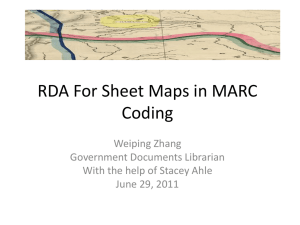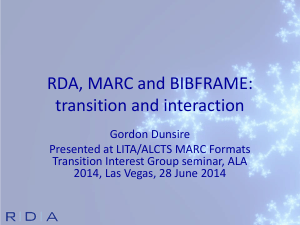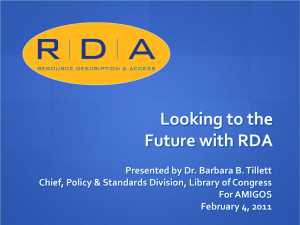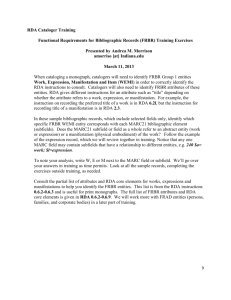RDA: What Does it Mean to School Library Resource Description
advertisement
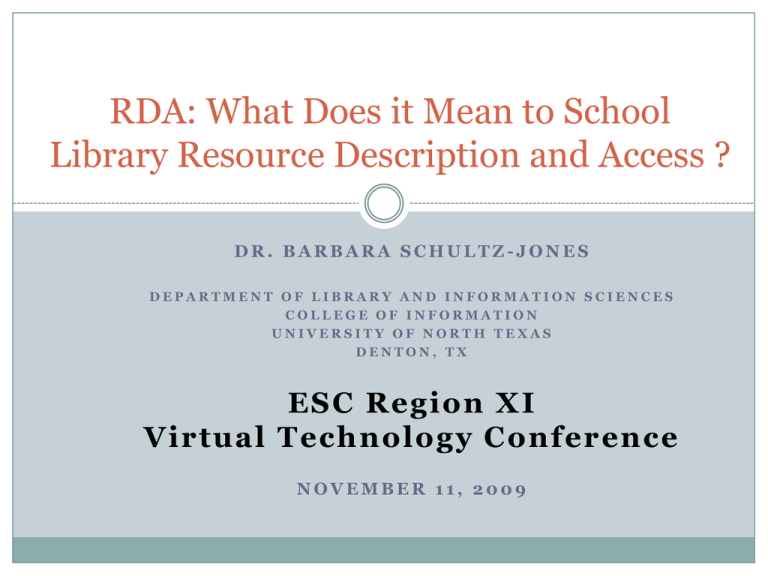
RDA: What Does it Mean to School Library Resource Description and Access ? DR. BARBARA SCHULTZ-JONES DEPARTMENT OF LIBRARY AND INFORMATION SCIENCES COLLEGE OF INFORMATION UNIVERSITY OF NORTH TEXAS DENTON, TX ESC Region XI Virtual Technology Conference NOVEMBER 11, 2009 Objectives 2 Understand the role of FRBR and FRAD in Resource Description and Access (RDA) Understand the impact of RDA on cataloging tasks Understand the impact of RDA on user operations Consider a strategy for implementing RDA in the school library media center What do I need to learn about RDA? 3 • The main questions being asked are: How do we use it? How do we implement it in our library? Are vendors creating new systems that use it? • Perhaps the most challenging aspect will be learning the complexity of the FRBR entityrelationship models in which information resources are classified as: • Works, Expressions, Manifestations, and Items (often referred to as WEMI). Where we are and how we got here 4 Resource Description and Access (RDA) replaces Anglo-American Cataloguing Rules, 2nd ed. (AACR2) in January 2010, as an online database product to incorporate the features and functionalities of online access. (JSC, www.rda-jsc.org/) Work began in 2004, initially conceived as AACR3 but need for greater flexibility drove the movement to a new approach Based in part on conceptual models in Functional Requirements for Bibliographic Records (FRBR) and Functional Requirements for Authority Data (FRAD) Motivated by : Changes in technology • Impact on descriptive/access data • Book catalogs • Card catalogs • OPACs • Next generation Move from the isolated individual library to incorporation of the international audience Move from classes of materials to elements and values (more controlled vocabularies) Bibliographic Universe Books Serials Maps, globes, etc. Manuscripts. Musical scores A-V sound recordings motion pictures photographs, slides Multimedia “Remote” digital materials Etc. 5 Intention of RDA 6 Broaden the statement of principles (Paris Principles) All types of resources (not just books) Bibliographic relationships, descriptive cataloging, not Subject Cataloging at this time Access (not just choice and form of entry, but all access for bibliographic and authority records) Builds on Great cataloguing traditions of the world FRBR and FRAD and future FR-Subjects AACR2 vs. RDA: Difference in Proportions 7 AACR2 Description of information entities—13 chapters (Part 1) Weak on access points; talks of main and added (MAP, AAP), have to look all over Part II for access point provisions (e.g., title access points are discussed in chapter 21 only and then only as a default provision, not much direction) Is not really based on the idea of a “work”, rather it is very much based on the unit record system. AACR2 vs. RDA, continued 8 RDA Description is covered in 4 chapters, everything else is about access points Form is no longer the first decision; chapters are not based on form (e.g., no longer have chapters 2-12 as in AACR2) Does not focus on the unit record system—it can be, but it doesn’t need to do so—rather it operates on the idea of a “work” Does not put the cataloger in the decision of having to decide Main and Added Access points; we don’t need those distinctions any longer although it does use the idea of a “preferred access point” RDA and AACR2 9 How RDA Differs from AACR2 How RDA is similar to AACR2 Not organized by form Most rules will not of item Based on the Functional Requirements for Bibliographic Records (FRBR) change Discusses description and access points RESOURCE DESCRIPTION AND ACCESS (RDA) RECORDING ATTRIBUTES Introduction Section 1. Chapters 1-4 Recording attributes of manifestation and item Section 2. Chapters 5-7 Recording attributes of work and expression Section 3. Chapters 8-11 Recording attributes of person, family, and corporate body Section 4. Chapters 12-16 Recording attributes of concept, object, event, and place RECORDING RELATIONSHIPS Section 5. Chapter 17 Recording primary relationships between work, expression, manifestation, and item Section 6. Chapters 18-22 Recording relationships to persons, families, and corporate bodies Section 7. Chapters 23 Recording relationships to concepts, objects, events, and places associated with a work Section 8. Chapters 24-28 Recording relationships between works, expressions, manifestations, and items Section 9. Chapters 29-32 Recording relationships between persons, families, and corporate bodies Section 10. Chapters 33-37 Recording relationships between concepts, objects, events, and places Appendices A-M Glossary ANGLO-AMERICAN CATALOGUING RULES, 2ND ED., REV. PART I DESCRIPTION Introduction Chapter 1. General Rules Chapters 2-12 Special rules applicable to particular types of information resources (i.e., maps, manuscripts, music, etc.) Chapter 13 Analytical descriptions PART I HEADINGS, UNIFORM TITLES AND REFERENCES Chapter 20 Introduction Chapter 21 Choice of Access points [main and added] Chapter 22 Headings for persons Chapter 23 Geographic names Chapter 24 Headings for Corporate Bodies Chapter 25 Uniform Titles Chapter 26 References Appendices A-E Index 10 How much must I re-learn? 11 RDA now outlines the first step in creating a catalog record as deciding on the type of description to be represented, and not deciding on format, although format is still integral Types of description (rules 1.2) Comprehensive, analytical, or multi-level description More emphasis on showing bibliographic relationships (e.g., taxonomy of bibliographic relationships) in order to better allow clustering of records Read--works by B. Tillett, R. Smiraglia; M. Yee, S. Vellucci, E. O’Neill, D. Vizine-Goetz, just to name a few… Preparation 12 Cataloging community must study the conceptual model offered by FRBR and FRAD Read and study drafts of RDA as released Provide feedback to JSC and vendors Vendors must consider a re-design of their automation systems in order to incorporate new functionality of bibliographic and authority data Vendors producing bibliographic records must consider how and when to add the new RDA fields to MARC records What’s a conceptual model? 13 • Abstract depiction of the universe of things being described The things in that universe (entities) Identifying characteristics of those entities (attributes/elements) The relationships among the entities Why do we need FRBR? 14 Improve the user experience in locating information Guide systems designs for the future Guide rule makers Cut costs for the description and access to resources in our libraries Position information providers to better operate in the Internet environment and beyond Applications of the Conceptual Model 15 FRBR is conceptual model Opportunities for the future in new systems designs No application is prescribed Australia, Europe Variations3, etc. Keep user foremost in mind Functional Requirements for Bibliographic Records (FRBR) 16 User tasks Entity-relationship model Find Identify Select Obtain Entities: Group 1, 2, 3 Relationships Attributes National level record elements (mandatory & optional data) FRBR Entities 17 Group 1:Products of intellectual & artistic endeavor = bibliographic resources Work Expression Manifestation Item FRBR’s Entity-Relationship Model 18 Entities Relationships Attributes (data elements) relationship One Entity Another Entity FRBR’s Entity-Relationship Model Work Person 19 created was created by Shakespeare Hamlet Work is realized through Expression Intellectual/ artistic content Physical recording of content is embodied in Manifestation is exemplified by Item 20 Vocabulary 21 “Book” –Door prop (item) –“publication” at bookstore any copy (manifestation) Vocabulary 22 “Book” –Who translated? (expression) –Who wrote? (work) Group 1 Work is realized through Expression is embodied in Manifestation recursive one is exemplified by Item many 23 Elements to Describe Resources Manifestation ID Title Statement of responsibility Edition Imprint (place, publisher, date) Form/extent of carrier Terms of availability Mode of access etc. Item ID Provenance Location etc. Work ID Title Date etc. Expression ID Form Date Language etc. 24 Work 25 Les Trois Mousquetaires French text movie Expressions 26 books Videocassettes DVDs Manifestations CDs 27 Examples 28 1. 2. 3. 4. 5. Leatherbound autographed copy in Rare Books Collection? Item Digitized version of the Oxford University Press text published in 2008? Manifestation French translation? Expression London Symphony Orchestra 2005 performance? The Three Musketeers? Expression Work Family of Works Equivalent Descriptive Derivative Free Translation Edition Microform Reproduction Simultaneous “Publication” Abridged Edition Copy Revision Exact Reproduction Translation Facsimile Reprint Original Work - Same Expression Variations or Versions Illustrated Edition Summary Abstract Dramatization Digest Novelization Screenplay Libretto Review Casebook Criticism Evaluation Change of Genre Parody Annotated Imitation Edition Expurgated Edition Arrangement Same Style or Thematic Content Commentary Slight Modification Same Work – New Expression Adaptation Cataloging Rules Cut29Off Point New Work Relationships Work Expression Inherent among the Group 1 entities Content relationships among works/expressions Manifestation Item Whole-Part Derivative Sequential Accompanying 30 FRBR Entities 31 Group 1: Bibliographic resources Work Expression Manifestation Item FRBR Entities 32 Group 2: Those responsible for the intellectual & artistic content = Parties Person Corporate body Family Relationship vs. Element 33 Work Created by Creates Person Shakespeare Hamlet Work Group 2 Expression Manifestation Item is owned by Person is produced by Family is realized by is created by Corporate Body many 34 FRBR Entities 35 Group 3:Subjects of works Groups 1 & 2 plus Concept Object Event Place Subject relationship Subject Relationship 36 Work Created by Creates Person Concept/Topic Work Work Expression has as subject Manifestation Item Person Family has as subject Corporate Body Group 3 Concept Object has as subject Event Place many 37 FRBR Benefits 38 Collocation Better organization to catalog More options to display • Identifying elements • Pathways Simplify cataloging enabling links and re-use of identifying elements Objectives of Catalogs 39 Cutter’s objectives for the catalog Finding - description and access standards Collocating - controlled “vocabularies” for precision of searching “User Tasks” - FRBR 40 Find (locate and collocate) Identify Select Obtain Relate/Navigate Objectives of Catalogs 41 Finding (locate) A single specific resource Collocating (sets of resources) All resources belonging to the same work All resources belonging to the same expression All resources belonging to the same manifestation All the works and expressions of a person, corporate body, or family All resources on a given subject All resources sharing some specific characteristic Language, place of publication, date, etc. Collocation by Works 42 Shakespeare, William, 1564-1616. + All’s well that ends well + As you like it + Hamlet + Macbeth + Midsummer night’s dream + … Collocation by Family of Works and Expressions 43 Shakespeare, William, 1564-1616. Hamlet. + Texts + Motion Pictures + Sound Recordings Collocation by Expressions 44 Shakespeare, William, 1564-1616. Hamlet. + Texts – Danish + Texts – Dutch + Texts – English + Texts – French + Texts – Spanish + Motion Pictures – English + Sound Recordings - English Collocation of Manifestations 45 Shakespeare, William, 1564-1616. Hamlet. - Motion pictures – English + + + + + + 1964 Director, Bill Collegan 1990 Director, Kevin Kline, Kirk Browning 1990 Director, Franco Zeffirelli 1992 Director, Maria Muat 1996 Director, Kenneth Branagh 2000 Director, Campbell Scott, Eric Simonson Collocation Objectives of a Hamlet catalog: display Shakespeare All the works associated with a person, etc. All the expressions of the same work All the manifestations of the same expression All items/copies of the same manifestation English Romeo and Juliet French German Swedish Stockholm 2008 Library of Congress Copy 1 Green leather binding 46 Pathways to Related Works Shakespeare Stoppard Hamlet Rosencrantz & Guildenstern Are Dead Text English Movies … Romeo and Juliet French German Swedish Stockholm 2008 Library of Congress Copy 1 Green leather binding 47 Shakespeare, William, 1564-1616. Hamlet. French. LC Control No. LCCN Permalink Type of Material Personal Name Main Title Published/Created Description : : : : : : : 47023612 http://lccn.loc.gov/47023612 Book (Print, Microform, Electronic, etc.) Shakespeare, William, 1564-1616. ... Hamlet, traduit par André Gide. [Paris] Gallimard [1946] 2 p. l., 7-237, [2] p. 17 cm. CALL NUMBER -- Request in : PR2779.H3 G5Copy 1 : Jefferson or Adams Bldg General or Area Studies Reading Rms 48 Shakespeare, William, 1564-1616. Hamlet. French. LC Control No. LCCN Permalink Type of Material Personal Name Main Title Published/Created Description : : : : : : : 47023612 http://lccn.loc.gov/47023612 Book (Print, Microform, Electronic, etc.) Shakespeare, William, 1564-1616. ... Hamlet, traduit par André Gide. [Paris] Gallimard [1946] 2 p. l., 7-237, [2] p. 17 cm. CALL NUMBER -- Request in : PR2779.H3 G5Copy 1 : Jefferson or Adams Bldg General or Area Studies Reading Rms Person 49 Work Shakespeare, William, 1564-1616. Hamlet. French. Expression LC Control No. LCCN Permalink Type of Material Personal Name Main Title Published/Created Description : : : : : : : 47023612 http://lccn.loc.gov/47023612 Book (Print, Microform, Electronic, etc.) Shakespeare, William, 1564-1616. ... Hamlet, traduit par André Gide. [Paris] Gallimard [1946] 2 p. l., 7-237, [2] p. 17 cm. CALL NUMBER -- Request in : PR2779.H3 G5Copy 1 : Jefferson or Adams Bldg General or Area Studies Reading Rms 50 Shakespeare, William, 1564-1616. Hamlet. French. Manifestation LC Control No. LCCN Permalink Type of Material Personal Name Main Title Published/Created Description : : : : : : : 47023612 http://lccn.loc.gov/47023612 Book (Print, Microform, Electronic, etc.) Shakespeare, William, 1564-1616. ... Hamlet, traduit par André Gide. [Paris] Gallimard [1946] 2 p. l., 7-237, [2] p. 17 cm. CALL NUMBER -- Request in : PR2779.H3 G5Copy 1 : Jefferson or Adams Bldg General or Area Studies Reading Rms 51 Shakespeare, William, 1564-1616. Hamlet. French. LC Control No. LCCN Permalink Type of Material Personal Name Main Title Published/Created Description : : : : : : : 47023612 http://lccn.loc.gov/47023612 Book (Print, Microform, Electronic, etc.) Shakespeare, William, 1564-1616. ... Hamlet, traduit par André Gide. [Paris] Gallimard [1946] 2 p. l., 7-237, [2] p. 17 cm. CALL NUMBER -- Request in : PR2779.H3 G5Copy 1 : Jefferson or Adams Bldg General or Area Studies Reading Rms 52 Item FRBR-based systems 54 Concept Person Work Person Expression Manifestation Manifestation Item Corporate body Item Item MARC 21 Changes (slide from “RDA and OCLC”, Webinar presentation, October 2009. K. Calhoun, J. Godby, T. Fons, and G.Patton) 55 Bibliographic records 040 ‡e code ‘rda’ to identify the rules used New fields for content type, media type and carrier type Field 336 – Content type Field 337 – Media type Field 338 – Carrier type Authority records 040 ‡e code ‘rda’ to identify the rules used Other fields for entity attributes OCLC implementation in time for use in the testing Content, media, and carrier types 56 Content type MARC Leader/06 - must continue to use Less granular than RDA MARC LDR/06 code examples • e - cartographic material • f - manuscript cartographic material New field 336 - use to record exact RDA terms $a Content type terms $2 Source RDA term examples • cartographic dataset • cartographic image • cartographic moving image • cartographic tactile image • cartographic tactile three-dimensional form • cartographic three-dimensional form 336 ## $a cartographic dataset $2 rda Content, media, and carrier types 57 Media type MARC 007/00 – close match with RDA 007 provides coding for multiple facets of resource MARC 007/00 code examples • h - microform • s - sound recording New field 337 - use to record exact RDA terms and/or do not need to code additional facets of resource $a Media type term $2 Source RDA term examples • microform • audio 337 ## $a microform $2 rda 337 ## $a audio $2 rda Content, media, and carrier types 58 Carrier type MARC 007/01 – close match with RDA 007 provides coding for multiple facets of resource MARC 007/01 code examples • b - microfilm cartridge • d - sound disc New field 338 - use to record exact RDA terms and do not need to code additional facets of resource $a Carrier type term $2 Source RDA term examples • microform cartridge • audio disc 338 ## $a microfilm cartridge $2 rda 338 ## $a audio disc $2 rda Who’s ready now? 59 VTLS - Virtua http://www.vtls.com/products/virtua Automation system designed with FRBR concepts The Primo® system from Ex Libris http://www.exlibrisgroup.com FRBRized interface to streamline the discovery process. Linked bibliographic and authority records NAME AUTHORITY RECORD 100 $a Preferred name for the person $d Date of birth 400 $a Variant name for the person 500 $a Preferred name for the person $c Title of the person $0 Identifier for the person … 1 BIBLIOGRAPHIC RECORD 100 $a Preferred name for the person $d Date of birth 240 $a Preferred title for the work $l Language of expression 245 $a Title proper $c Statement of responsibility relating to title proper 250 $a Designation of edition 260 $a Place of publication $b Publisher’s name $c Date of publication 300 $a Extent 338 $a Carrier type 500 $a Nature of the content … 700 $a Preferred name for the person $c Title of the person $e Relationship designator 700 $a Preferred name for the person $c Profession or occupation $e Relationship designator 730 $a Preferred title for the work $d Date of work 740 $a Variant title 2 NAME-TITLE AUTHORITY RECORD 100 $a Preferred name for the person $d Date of birth $t Preferred title for the work $l Language of expression 530 $a Preferred title for the work $d Date of work $0 Identifier for the work … 3 NAME AUTHORITY RECORD 100 $a Preferred name for the person $c Title of the person 400 $a Variant name for the person 500 $a Preferred name for the person $d Date of birth $0 Identifier for the person … NAME AUTHORITY RECORD HOLDINGS RECORD 506 $a Restrictions on access 561 $a Custodial history of item 562 $a Item-specific carrier characteristic … 100 $a Preferred name for the person $c Profession or occupation 400 $a Variant name for the person … TITLE AUTHORITY RECORD 130 $a Preferred title for the work $d Date of work 500 $a Preferred name for the person $d Date of birth $t Preferred title for the work $l Language of expression $0 Identifier for the work … Manifestation Record - VTLS 61 Next Steps 62 RDA Testing January – March 2010 April – June 2010 Formal testing (23 of 90 selected) LIS educators included in test group; UNT participating NEISD San Antonio representing school libraries July – September 2010 Preparatory period, preliminary use of RDA and RDA Online tool Formal Assessment October 2010 Final report shared with U.S. library community Vendor adoption, creativity and design! Questions? Thank You. http://www.rda-jsc.org/rda.html http://www.rdaonline.org/constituencyreview/ http://www.loc.gov/bibliographic -future/rda/ http://www.rdaonline.org


